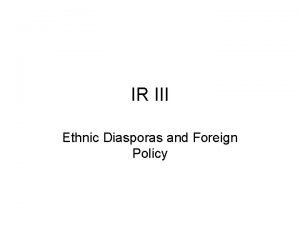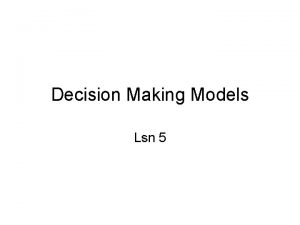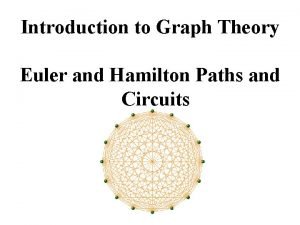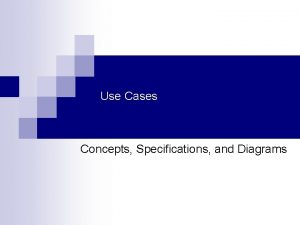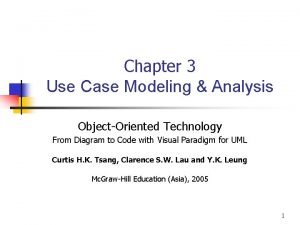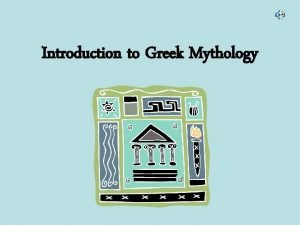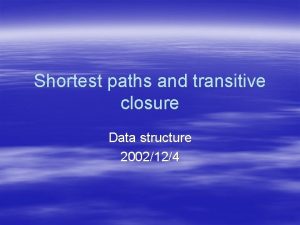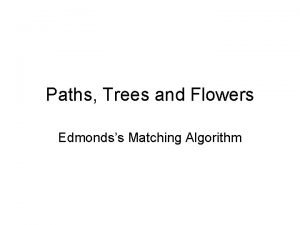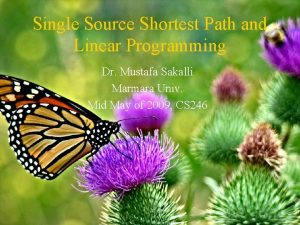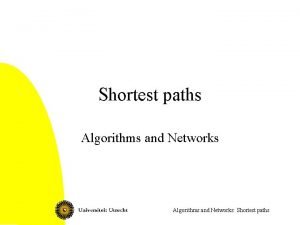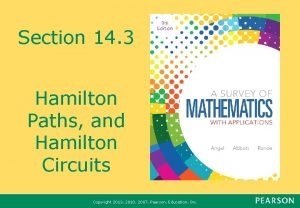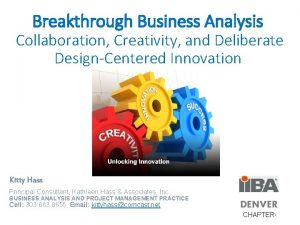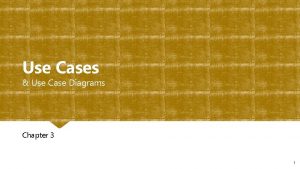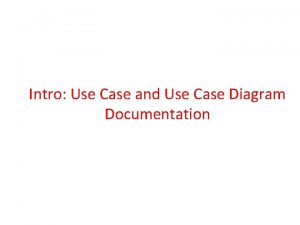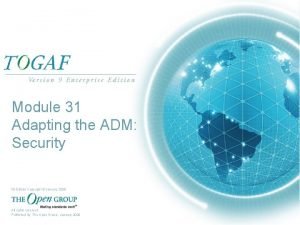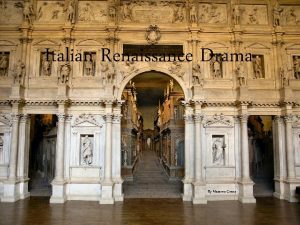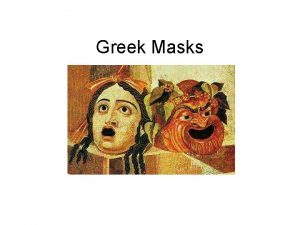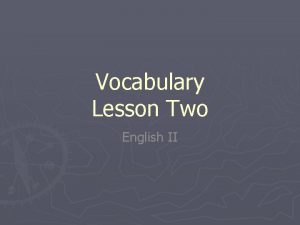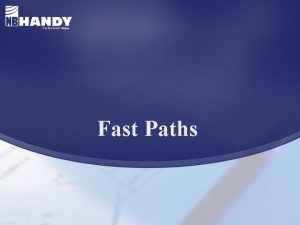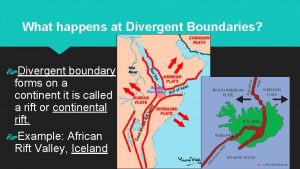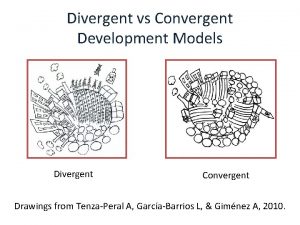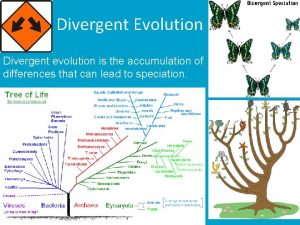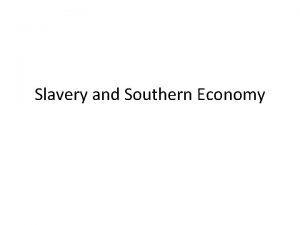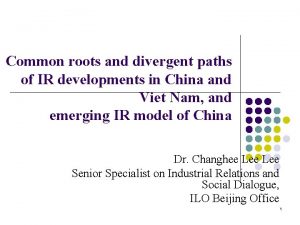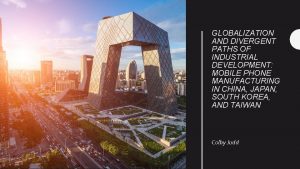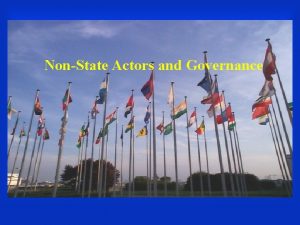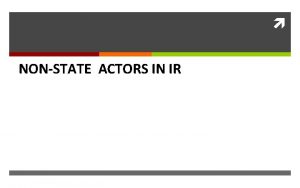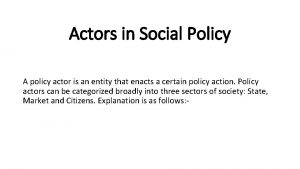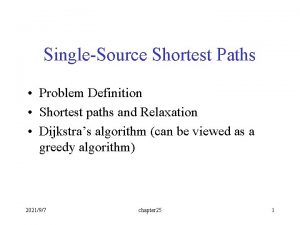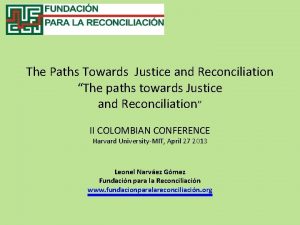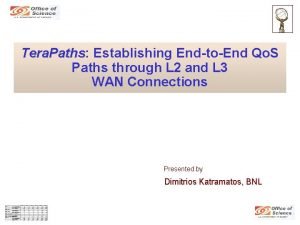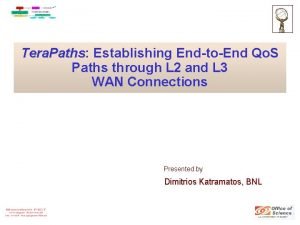Divergent Paths of Actors and Policy Learning A

































- Slides: 33

Divergent Paths of Actors and Policy Learning: A Comparative Study of the Oil Palm Systems of Innovation in Malaysia and Nigeria Boladale O. Abiola Adebowale Ph. D Candidate: University of Malaya, Kuala Lumpur, Malaysia daleabiola@perdanamail. um. edu. my Senior Research Officer: National Centre for Technology Management (NACETEM), Obafemi Awolowo University, Ile-Ife, Nigeria. daleabiola. adebowale@nacetem. org daleabiola@yahoo. com Divergent Paths of Actors & Policy Learning Boladale O. Abiola Adebowale

Outline n Background/Introduction Why Oil Palm? n Why Malaysia and Nigeria? n Research Objective and Proposition n Theoretical Literature n Methods n Preliminary Findings n Conclusions n Divergent Paths of Actors & Policy Learning Boladale O. Abiola Adebowale 2

Background/Introduction n The study focuses on the processes and institutions involved in what has been framed as the economic catch up process. n What processes and institutions fostered, the rapid progress made by countries in South East Asia, and n Why and how did Sub-Saharan Africa (SSA) fall so far behind? Divergent Paths of Actors & Policy Learning Boladale O. Abiola Adebowale 3

Background/Introduction Per Capita GDP in current prices US Dollars (Asia and Africa 1970 – 2004) 6000 5500 5000 4500 4000 3500 3000 2500 2000 1500 1000 500 0 China Malaysia Ghana South Africa 1 0 97 1 5 97 Divergent Paths of Actors & Policy Learning 1 0 98 1 5 98 0 99 1 1 5 99 2 0 00 Boladale O. Abiola Adebowale 4 00 Nigeria 2 4

Background/Introduction n Fifty years ago the two regions and the two tropical countries under study were rural peasantries with low living standards. n On the one hand one set of countries have advanced into export-oriented manufacturing industries with a strong base of technological capabilities while the other has remained largely agrarian societies with low technological capabilities across most sectors (Lall and Pietrobelli 2002). n In the export of what was Africa’s comparative advantage much ground has now been lost to Asia in the export of traditional African agricultural products like palm oil, coffee and cocoa (Oyelaran-Oyeyinka, 2006). Divergent Paths of Actors & Policy Learning Boladale O. Abiola Adebowale 5

Why Malaysia and Nigeria? Divergent Paths of Actors & Policy Learning Boladale O. Abiola Adebowale 6

Sector: Oil Palm Industry n Oil Palm is indigenous to Africa but a borrowed technology to Asia. It is the highest Oil yielding tree crop having the following products and uses: 7

Sector: Oil Palm Industry in Malaysia: often viewed as a country that evolved from dependence on tin and rubber to export-oriented manufacturing dominated by electronics assembly. But the commodity that took the country to the technological frontier is palm oil. Oil palm is now a major pillar of Malaysia’s industrialization. n Malaysia overtook Nigeria as the world’s leading exporter and producer of palm oil in 1966 and 1971 respectively (Gopal 2001). n Malaysia now accounts for about half of the world production of palm oil and has evolved from simple cultivation and crude oil processing to become the industry’s leading innovator, controlling the industry’s value-added chain. Divergent Paths of Actors & Policy Learning Boladale O. Abiola Adebowale 8

Sector: Oil Palm Industry n Nigeria was the largest producers and exporter until 1966 and 1971 n There has been an annual increase of 2. 5% in production, but Nigeria is no longer at the forefront of oil palm & products export n The initial stagnation has been blamed on lack of government policies and other issues pertaining to new interest (crude oil boom). However the ffg probes the mind: n n n How was Malaysia able to build a successful Oil Palm industry? Why have Malaysian companies become major players in the global stage? Why has the industry in the two countries followed different paths? Divergent Paths of Actors & Policy Learning Boladale O. Abiola Adebowale 9

Research Philosophy n The central proposition of this thesis is that the divergent paths of sectoral development have been defined by differences in institutional, policy and technological trajectories; n And it is about the nature of differentiated development examined from sectoral innovation system, historical and technological perspectives Divergent Paths of Actors & Policy Learning Boladale O. Abiola Adebowale 10

Research Questions n What are the roles of institutions, organizations and policy in the development of the oil palm industry in the two countries? n How do these factors converge with science and technological instruments that the two countries adopted? n What are the nature and characteristics of the sectoral systems of innovation that support the development of the sector? Divergent Paths of Actors & Policy Learning Boladale O. Abiola Adebowale 11

Research Questions n What specific role did the two governments play in terms of sector policies? n What microeconomic policies underline the interactive learning, technological capabilities driving the sector? n What is the specific role of new technologies, and how do technological knowledge infrastructure promotes separate national development? Divergent Paths of Actors & Policy Learning Boladale O. Abiola Adebowale 12

Specific Objectives n Systematically investigate the co-evolution of institutions, policies and technologies that are determinants of the uneven development of the oil palm and processing sectors in Nigeria and Malaysia; n Examine the nature and capability of actors and compare these in the oil palm industry of the two countries; n Examine the types, levels and intensity of interaction between the actors in the oil palm industry; n Systematically examine the scientific and technological infrastructure in Malaysia and Nigeria and how these affect innovation and performance of the oil palm sector. Divergent Paths of Actors & Policy Learning Boladale O. Abiola Adebowale 13

Research Propositions The propositions guiding the research: n P 1. The observed divergence in the sectoral development of the palm oil industry in the two countries is a result of different institutional, organizational and policy settings. (Combined with P 2 in Chapter 3) n P 2: The nature and capability (human capital) of actors (organizations and industrial firms) will determine the speed and trajectory of development of industry in the two countries. n P 3: Interactive Learning among firms is a major source of growth and innovation performance of the sector (Review in chapter 2 and Empirical findings in Chapter 4). n P 4 Innovation and Production Performance is determined by a wide array of policy, technological and human capital factors (Empirical findings and Case Study in Chapter 5) n P 5: The capacity of scientific and technological infrastructure as well as the nature of science and technology applied over time will condition the evolution and performance of the sectors (Chapter 6) Divergent Paths of Actors & Policy Learning Boladale O. Abiola Adebowale 14

Theoretical Literature n Literature on technological capabilities broadly and in latecomer context (Dosi, Nelson et al. 1997, Bell and Pavitt, 1993, 1995) n Second, we examine the systems of innovation framework and how systems differ in different contexts (Freeman 1987; Lundvall 1992; Edquist and Johnson 1997). Innovation Systems bothers on the following n Actor centred approach i. e identify key actors n Interactive approach which guides policy makers n Institutionally noted- it operates within a context n Historical path dependent approach n The third broad perspective is the nature of institutions and how it underpins innovation systems, as well as the dynamics of national and global integration through global value chains (GVCs) North (1996). n This theory helps to relate national actions with global dynamism or lack thereof of firms particularly as the oil palm in Malaysia has become a highly global sector while the one in Nigeria is largely oriented to the domestic 15 market.

Methodology Framework Model: BOLADALE ABIOLA ADEBOWALE 2006. BACKGROUND Nigeria: . Gaps in capability. Lack of required huge capital. Lost ground as largest exporter. Inability to meet domestic and global demands. Lack of incentives: R&D funding; land tenure …. Inconsistent government policies. Low level of technology development SYSTEM ACTORS THE NATIONAL SYSTEM Malaysi a S E C T O R: The Oil Palm Industry Innovation Malaysia: . Breaking new grounds in techn. World leading producer &exporter . . Government Nigeri a Science, Technology & Innovation Support System THE VALUE CHAIN PROCESS UPSTRE AM Oil Palm Cultivation. Semi/ wild groves. Estate Scale: Small, Med & Large DOWNSTREAM Milling: - Crude Palm Oil Kernel oil extraction Palm Kernel cake. PROCESSING Refining & Fractionation - Processes oils & By-Products =>(Oleo chemical Industry, Speciality Fats, Consumer Oils & Fats Independent Variables of the System Learning Capabilities & Competence. Age & size of economic actor. Years of experience. Infrastructure. R&D funding. Human skills. Access to current journal. Access to physical tools, chem. . Access to funds (R&D incentives) Bodies. Universities. Industries. Research Institutes (Public & Private). Financial Institutions. Farmers Collaborative Interaction. Joint research. Joint training. Exchange of Personnel. Co- authorship. Linkage between firm & Supplier. University & Industry linkage. PRI & firm. Involvement with Cooperatives Performance. Technical skills. Infrastructure (land, water. Access to investment. Access to Information. Working capital. Access to inputs materials Such as fertilizers, pesticide MARKETS . Domestic. Export Intervening Variables. Climate. IPR. Political factors. Tariffs (export & import). Domestic demands STI Support System. Advances in techniques (TC, Genetic Imprvt, DNA…). Access to state of art equipments 16. Disease resistance. Pest resistance

Study Area n Malaysia n Located in the Southeastern Asia n Population: over 21 million people n Total land mass of 329, 750 sq. km. n Climate is tropical with a heavy annual rainfall of 2500 mm. n Areas covered: Sabah, Sarawak and Peninsular Malaysia (7 states) n Nigeria n Located on the West coast of the African continent n Population: about 140 million people n Total Land mass of 923, 768 sq. km n Climate is tropical with average annual rainfall of 1, 2501, 500 mm much of the west and centre of Nigeria. Divergent Paths of Actors & Policy Learning Boladale O. Abiola Adebowale 17

Research Design n Multi-method approach & different sources of data were used for this study and these include: Small & Medium Scale Farmers n Primary data (large-scale survey Large Estate studies using questionnaires to establish the context) n Secondary data: (previous studies along with official reports and documents), and n Case studies (of firms, organizations, institutions, products and processes) Divergent Paths of Actors & Policy Learning Research Organization s/ Regulatory Bodies Boladale O. Abiola Adebowale Nigeria Malaysia 346 Qs Admin & Retrieved NB: 10% of farmers population in the areas surveyed Data partly from Malaysian Agricultural Census Board Q: 15 Admin & 12 Retrieved C: i)Presco Plc ii) Okumu Oil & Mills Sec Data partly from Malaysian Agricultural Census Board C: Sime Darby Sec Data C: NIFOR C: MPOB (PORIM & PORLA) 18

Divergent Paths of Actors & Policy Learning Boladale O. Abiola Adebowale 19

Research Findings (Partial) Malaysia Nigeria Firms (Holding) Highly consolidated Category I, III Not organized Mostly small scale (60% wild grove) small, medium & large Nature of Actors Estates ( Largest plantation is 335, 536 Ha) Small in size (Firm with largest planted mature area is 10, 684 Ha) Total Hectarage 4, 165, 000 Ha (as at Jan 2007) 2, 514, 090 Ha Nature of Global Market Leader Domestic Market Boladale O. Abiola Adebowale Divergent Paths of Actors & Orientation Policy Learning 20

Research Findings (Partial) Comparing Key issues in Malaysia and Nigeria The parameters that are used include: n Investment in research and development n Malaysia’s average spending per scientist grew from $175, 000 in 1981 to $344, 000 in 2002 and as at 2007 the figure has moved up to $500, 000. n Nigeria has the largest number of FTE researchers in Africa (11% of the region’s total), its spending at only 7%. Malaysia: targets research areas under the scheme called Intensification of Research in Priority Area (IRPA) Nigeria: conducts a large part of agricultural research – expectedly and as with much of other African countries, there is little research capacity in the private sector. Given the NIFOR case study, only 4% of the approved budget of the institute was released for a period spanning 10 years. Even then, the sum of money released is only a fraction of the ideal funding requirement (total $1, 450, 000). And for the period between 1992 to 2002, no fund was released for R&D. Divergent Paths of Actors & Policy Learning Boladale O. Abiola Adebowale 21

Research Findings (Partial) Comparing Key issues in Malaysia and Nigeria Trend in the source of funding amongst the small scale farmers in Nigeria 2002 -2007 2002 2003 2004 2005 2006 2007 Source Government 0. 9 0. 6 0. 9 0. 3 0. 6 n. a Family 14. 2 15. 3 14. 5 14. 7 13. 9 n. a Self Generated 73. 1 74. 9 76. 3 76. 6 78. 6 16. 5 Bank 1. 4 0. 9 1. 2 0. 9 1. 4 0. 6 Cooperative/ Association 14. 5 13. 0 14. 7 14. 2 14. 7 5. 2 Other Sources 4. 3 4. 9 4. 3 4. 6 4. 3 2. 6 Source: Nigeria- Author’s Survey 2007 In Malaysia, the highest percentage of farmers and large firms claim to have sought funding assistance from the banks mostly through the government intervention because of the policies and incentives. Divergent Paths of Actors & Policy Learning Boladale O. Abiola Adebowale 22

Research Findings (Partial) Comparing Key issues in Malaysia and Nigeria n Ownership and farm size n n In Malaysia’s oil palm industry: Preponderance of large estate farms compared with Nigeria which is dominated by small scale farmers. Large estate farms are normally associated with higher productivity, better technology and thrive on substantial investment. Divergent Paths of Actors & Policy Learning Farm Ownership Nigeria (%) Malaysia (%) Self/Private 75. 7 53. 7 Employer/ Government 17. 2 45. 4 Family 6. 2 0. 9 Community 0. 6 - On Lease 0. 3 - Boladale O. Abiola Adebowale 23

Research Findings (Partial) Comparing Key issues in Malaysia and Nigeria Divergent Paths of Actors & Policy Learning Boladale O. Abiola Adebowale Source: Nigeria- Author’s Survey 2007 24

Research Findings (Partial) Comparing Key issues in Malaysia and Nigeria n Educational level of Actors i) Farmers ii) R&D Personnel Malaysia (MPOB) 25 % of Scientists with Ph. D 302 Technologies/Products (5 prods in NIFOR) Filed 200 patents (No patents in NIFOR) 30% of patents sold & commercialized Sources: Malaysia (2005) Agricultural Census; Nigeria: Author’s survey 2007 Divergent Paths of Actors & Policy Learning Boladale O. Abiola Adebowale 25

Research Findings (Partial) Comparing Key issues in Malaysia and Nigeria n Production and Export Orientation n Parallel with the increase in oil palm areas, production and exports of palm oil and palm oil products also increased. n From a share of only 7. 7 per cent of agricultural exports in 1970, palm oil exports now accounted for about 30 per cent of all agricultural exports. Malaysia n Almost half of World Palm Oil exports (49%) n Leading commodity export, surpassing petroleum export Nigeria n Zero Export. All domestic market Divergent Paths of Actors & Policy Learning Boladale O. Abiola Adebowale 26

Research Findings (Partial) Comparing Key issues in Malaysia and Nigeria Total Output from Oil Palm Plantation (amongst respondents) in Nigeria Source: Nigeria- Author’s Survey 2007 Divergent Paths of Actors & Policy Learning Boladale O. Abiola Adebowale 27

Institutional support for the oil palm industry under Industrial Master Plans 1 and 2 Human Resources Technology Financing Physical Infrastructure Tax & regulatory agencies Adapted process and R&D technology from PORIM Equity, own fund, bank, offshore loan and venture capital Cooking oil, margarine, vanaspati, frying fat. Cocoa butter subst, dough fat, salad oil etc Government incentives Adaptation, innovation & Developmt to enhance local technology for domestic use & export Equities, own fund, bank, access to offshore loan and venture capital Improved onshore Marketpumping facilities, coordinated more onshore storage & incentives handling facilities and utilities, particularly in Sabah & Sarawak, to meet growing demand. IMP (1985 – 95) Training Institutes, Universities On- the- job training IMP 2 (1996 – date) PORIM-Institutions of higher learning to provide training, esplly on downstream pdts Training of R&D personnel Overseas training 28

Policies: Malaysia n Export-oriented industrialization (EOI) began in 1968 with enactment of the Investment Incentives Act. Oil palm acreage expanded dramatically, in part to settler schemes under the Federal Land Development Authority (FELDA). n The government’s promotion of oil palm was designed to diversify commercial crop production away from rubber, n To contribute to the government’s program of economic redistribution and poverty alleviation, expressed in the New Economic Policy (NEP) of 1971 Divergent Paths of Actors & Policy Learning Boladale O. Abiola Adebowale 29

Policies (2) n The reason for the expansion in the late sixties and early seventies can be almost wholly found in a change in government policy. From 1960 until 1968, a single export duty was applied to all forms of palm oil, regardless of degree of processing. n The New Biofuel Policy yet to be promulgated Divergent Paths of Actors & Policy Learning Boladale O. Abiola Adebowale 30

Contrasting Trajectory of Malaysia & Nigeria Divergent Paths of Actors & Policy Learning Boladale O. Abiola Adebowale 31

In Conclusion The critical drivers that helped make Malaysia the world’s leading exporter of palm oil & related prdts are: n Policy instruments and institutions that were created to support the industry has been strong and consistent. n Network connections and coordination among economic agents directly related to the operations of palm oil firms. n Developments at the firm level (including plantations and smallholdings), where production is carried out. n Consistent funding and investment in R&D Divergent Paths of Actors & Policy Learning Boladale O. Abiola Adebowale 32

n. Thank you for your attention Divergent Paths of Actors & Policy Learning Boladale O. Abiola Adebowale 33
 Actors in foreign policy
Actors in foreign policy Actors in foreign policy
Actors in foreign policy Networks and graphs circuits paths and graph structures
Networks and graphs circuits paths and graph structures Euler and hamilton paths and circuits
Euler and hamilton paths and circuits Cuadro comparativo e-learning m-learning b-learning
Cuadro comparativo e-learning m-learning b-learning Use case primary and secondary actors
Use case primary and secondary actors Pengertian include dan extend
Pengertian include dan extend Actors and forces in marketing environment
Actors and forces in marketing environment Needs wants and demands
Needs wants and demands What are use cases
What are use cases Famous hispanic singers and actors
Famous hispanic singers and actors Who are the children of zeus
Who are the children of zeus Shortest paths and transitive closure in data structure
Shortest paths and transitive closure in data structure Paths, trees, and flowers
Paths, trees, and flowers Difference constraints and shortest paths
Difference constraints and shortest paths Difference constraints and shortest paths
Difference constraints and shortest paths American idol
American idol Prime factorization of 630
Prime factorization of 630 Convergent boundary
Convergent boundary Convergent and divergent thinking
Convergent and divergent thinking Use case with multiple actors
Use case with multiple actors Include and extend in use case
Include and extend in use case Actors queue
Actors queue Introduction to use case diagram
Introduction to use case diagram Use case for online shopping
Use case for online shopping Security actors
Security actors Massimo ciocca
Massimo ciocca Ancient greek theatre masks
Ancient greek theatre masks Why did greek actors wear masks
Why did greek actors wear masks Actors in the microenvironment
Actors in the microenvironment A hated, repellant person or thing
A hated, repellant person or thing Othello character chart worksheet answers
Othello character chart worksheet answers Advantages and disadvantages of proscenium stage
Advantages and disadvantages of proscenium stage Global health actors
Global health actors
